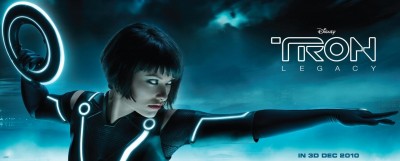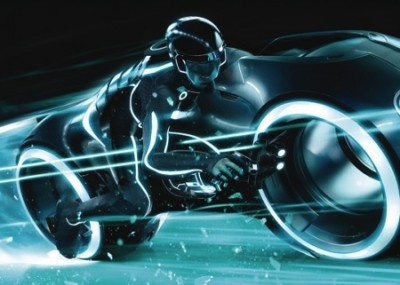Tron: Legacy comes 28 years after the original film, which was only a moderate box-office hit but later gained a cult following. Was it worth returning to The Grid, or is this sequel an exercise in empty nostalgia?
Picture this: one fine day, you meet someone who is so stunningly attractive that you are held in complete thrall. This unearthly beauty (ladies, just imagine a man) unwaveringly holds your slack-jawed gaze as she speaks in a hypnotic dulcet tone. You are mesmerised.
At some point however, the spell begins to wear off. Only then do you realise that her words aren’t quite adding up. It finally hits you: she wasn’t saying much of anything at all, just a whole lot of sweet nothings. But hey, it’s all good cos she’s just so friggin’ beautiful, maaan!
Yes. Say hello to my little analogy for the viewing experience of “Tron: Legacy”.

It would be too easy to sum the film up as being a triumph of style over substance. That’d make for a pretty short – and shallow – review. For those willing to brave the film’s vague attempts at profundity, there is indeed a discernible undercurrent of substance. The problem is that it doesn’t stand a chance against the sheer audio-visual seduction on display. Or rather, the filmmakers had something to say but did not follow through on what they were saying. So they focused on what they knew best: bringing The Cool. I’ll get to that momentarily. But first, the good stuff.
“Legacy” is one heck of a gorgeous film. Both to look at and to listen to. This is the kind of reference-level material that will inspire TV commercials and music videos for years to come. And rightfully so. Not since “Avatar” has there been a film that immerses its audience quite as deeply as this. Where James Cameron wowed us with extraterrestrial flora and fauna, here fledgling director Joseph Kosinski, bringing all the wealth of his background in architectural and industrial design, dazzles us with his vistas of glass, granite and steel. The people, places and technology are all remarkably conceived. This is world-building at its most vivid and fully formed.
I also dig the consistency. Too many sci-fi films have tried to present a particular vision, but they mostly ended up looking like a patchwork instead, lifted off various sources. In the digital world of The Grid, everything feels like it belongs and makes sense on its own terms, right down to the tiniest details like ice cubes (they’re in the shape of pixels!). Kosinski evidently possesses a singular vision, and has marshaled an army of set, costume and production designers to shape “Legacy” according to his own neo-minimalist aesthetic.
Of course, the imagery isn’t entirely original. Any geek worth his Republic Credits will spot familiar elements from classics like “Blade Runner”, “Star Wars” and even “The Matrix”. Actually, where “Legacy” draws most successfully from is the first “Tron”. If people remember anything at all from that movie, it would be the Lightcycle races and disc duels. Striking visual concepts on their own, but when you add the magic ingredient of colourful neons juxtaposed against inky blacks, the effect is breathtaking. And what’s old is new again.
Daft Punk is back in style too. The French duo’s pulsating, rousing score gives all the proceedings an added vigour. Although this time embellished with a lot more orchestral elements, their synthetic sound is a perfect fit for the visuals. This is phenomenal work, and has my vote as the best soundtrack of the year.
Kosinski knows how to infuse his bigger scenes with a sense of wonder. Key moments like main protagonist Sam Flynn’s arrival on The Grid, the Disc Wars sequence, or the updated Lightcycle battle, all have that electrical charge of occasion to them. It’s not just spectacle. You get the feeling you’re witnessing something special. Even the scene where Sam receives his disc and a groovy wardrobe change is conveyed with a surreal reverential tone.
Kosinski clearly has great love for the original, which was lauded for its (then) revolutionary visual effects. “Tron” was so far ahead of its time that the Academy of Motion Picture Arts and Sciences disqualified it from the 1982 Oscar’s Best Special Effects category because back then, the use of CGI was considered cheating. It later inspired animation pioneers like John Lasseter to establish Pixar Studios. Kosinski’s action homages retain that cutting-edge quality while (thankfully) avoiding the campiness. The Disc Wars are played deadly serious, with a much more brutal gladiatorial attitude. Deft choreography tightened by sharp editing drives home the fact that the game has changed: these are weapons that can, and do, cause grievous harm. It’s pretty thrilling.

The Lightcycle set-piece could’ve done with some of the original film’s clarity of staging. As crude and as static as that sequence looks by today’s standards, the action was always clear because the geography of the characters in relation to each other was always clearly laid out. This is a minor criticism though. Because the scene is the highlight of the film, easily trumping the somewhat pedestrian Lightjet showdown at the climax. While not so easy to follow, the Lightcycle chase is shot with a kind of heady kineticism, selling the fluidity that these otherworldly bikes are capable of. And oh my, what bikes these are. If ever there were a case to be made for Design being flat-out sexy, this would be Exhibit A.
Speaking of sexy, the new lightsuits have lost the old whoa-what’s-that-bulge leotard awkwardness and gone for a more understated biker-leather chic. I can already picture Cosplayers all over the world accidentally electrocuting themselves in an effort to recreate that nifty light-up feature.
Just as well that the cast looks incredibly good wearing the suits, for they are seldom called upon to do much more. Garrett Hedlund has Sam mostly alternating between Bruce Wayne dourness and schoolboy earnestness. The only time he demonstrates any real acting chops is in his reunion scene with his onscreen father, the long-lost Kevin Flynn. There’s a whole lot of emotional ambivalence in a guy with abandonment issues; now confronted with the man responsible for those feelings. Hedlund sells it by going subtle, letting his reactions boil just beneath the surface. Coupled with Jeff Bridges playing it slightly detached yet incredulous, the moment has a gentleness, a poignancy to it. Genuine heart that is curiously absent in later scenes between them.
I blame the director. He has a sure hand when directing pixels but seems out of his comfort zone with actors and dialogue. Surprisingly, it is Bridges who delivers the most inconsistent performance. Kosinski probably couldn’t decide whether he wanted Bridges to play Flynn as a wise old sage, an eccentric genius, a fiery god, or the stoner Dude from “The Big Lebowski”. So he let the man do all of the above. It makes for interesting viewing but a more reined-in performance would’ve grounded the father-son dynamic and made him more accessible to the audience.
Kosinski’s tendency to let actors run away unchecked with a role also shows up in Michael Sheen’s Castor, the flamboyant owner of the End Of The Line nightclub. Sheen, who modeled his portrayal after larger-than-life personalities like 70s David Bowie, is clearly having a blast. It’s a lot of fun and breathes some brevity into the otherwise sombre tone of the film. However, it’s also a jarring shift, made more obvious by the reams of serious plot exposition that precede Castor’s introduction.
Olivia Wilde as computer program Quorra comes off the best. She manages to strike the balance between wide-eyed naivete and steely resolve as Flynn’s protege and protector. She is quite simply the spark of warmth that “Legacy” frankly needed more of. That’s the danger when your film is so darned cool. The humanity tends to get left out in the cold.
The screenwriters deserve an equal measure of blame here. Perhaps out of unbridled ambition, or maybe it was just an inability to focus, but “Legacy” contains more themes than it can handle. Big ideas with loads of thematic potential are brought up, only to be left undeveloped. The most fascinating of which is the nature of godhood. Users, as humans in The Grid are known, are accorded the hushed devotion for a higher being. And in The Grid, Flynn is the ultimate User. He created all the programs, the sentient humanoids who populate this world.
Upon their reunion, Flynn tells his son of the emergence of a brand new lifeform on The Grid, called Isomorphic Algorithms, or ISOs. Not mere programs, but digital-based organisms. This is what Flynn claims will change science, medicine and religion on Earth. Because he didn’t create the ISOs; they manifested completely independently. At this point in the film, I was very intrigued. What’s this, a Disney-funded, mainstream Hollywood blockbuster pitting the theory of creation against the theory of evolution? By their standards it’s certainly an edgy theme. The questions it raises are manifold: Are there boundaries to omnipotency? What are they? At what point is the power of creation overtaken by the power of evolution? Or can they exist simultaneously?
The film never returns to that concept, let alone present us with an opinion of it. It’s as if writers Edward Kitsis and Adam Horowitz had absolutely no clue where to take the idea. Or they were simply content to introduce stuff like this as a way to imply, “Hey we’re not just about cool effects and fancy visuals, we’ve got depth!” The earlier-mentioned father-son relationship also falls short, making what is supposed to be an emotional climax at the end feel unearned. And worse, unmoving. I found this half-baked approach frustrating.
You know what else is half-baked? The synthespian. As in digital actor. With a US170 million-dollar budget, I expected a more convincing digital version of the young Jeff Bridges (as villainous program CLU, and in flashback scenes as a young Flynn). Instead, we get a creepy, dead-eyed plastic face that only occasionally manages to emote properly. The young Flynn scenes are especially embarrassing. I’d be more forgiving if it wasn’t so disruptive to what is otherwise a very immersive viewing experience. On that note, I’ll venture the contrary opinion by saying the 3D is NOT essential to the viewing experience. It’s cute at the best of times, and a hindrance to your eyesight the rest of the time.
In spite of its numerous shortcomings, “Legacy” is still an artistic triumph. This is Cinema of the Cool at its very best. At least on the surface alone, this is definitely one of 2010’s most cinematic films. What elevates it is the ambition to go beyond eye candy. I dare say it will have a more lasting appeal than something like “Avatar”. Bold words, I know. Though “Legacy” may have squandered its chance at being more than just a pretty face, I admire them for trying.
But maaan, what a pretty face, eh?
Storyteller by trade and dreamer by nature, Wai has been deeply nuts about the celluloid world since the first time he discovered he could watch a story instead of reading it. But he likes writing about it. Wai goes by a single name because he likes to avoid any “Imperial entanglements” (a.k.a. “conflict of interest with the powers that be” for those of you who don’t speak Star Wars) in his employment. Plus, cool people use one-word names.

the music is very importan in any film in this is wonderfull for me and not one septic tank
Hey folks, my thanks as always for the feedback…
lishun: to me, the best score Oscar is a toss-up between Daft Punk, Hans Zimmer for "Inception", and Trent Reznor/Atticus Ross for "The Social Network". All 3 are brilliant.
dreong & Leroy Luar: yeah Olivia Wilde is hot. Look out for her in the upcoming "Cowboys & Aliens".
Eloise: those are pretty good questions. My take on some of them… Food and drinks are synthesised by Flynn in the same way his organic matter was digitised into the world of The Grid. How that's possible is anyone's guess. As to how he created his own place off The Grid, well he is a User and in this world has the power to create stuff whenever and wherever he wants. Quorra can survive in the real world in the same way humans can survive in The Grid. She is after all (spoiler alert!) a living organism, and not just a program. Albeit a non carbon-based lifeform.
Gwen10: good point about Tron being an afterthought in his own film. Then again, even in the first film, he wasn't really the main protagonist, in the sense of true character arc and significance to the overall plot. It was always primarily Flynn's story. Btw, you CAN get those bikes. Or at least the collectible version of them, from companies like Hot Toys and Sideshow…
Alie: I loved the Boston Terrier pup too! Gotta get me one of those… As for Avatar's story, I wasn't a big fan of the overly-familiar plot beats. People have blasted it for being a riff on "Dances With Wolves" and "Ferngully". Which isn't a crime it itself, since many films draw on existing genre conventions. It's just that Cameron painted his story in strokes that were way too broad, and over-used.
I think Tron was a very artistic pretty movie… Was a tad disappointed that the movie did not have enough substance and I feel the emotions that should have been shown through was not impactful enough. Flynn seemed more like a whiney adolescent instead of a young man who still thinks of his dad. Flynn Sr was a bit weird.. Must be years of boredom in the Grid that caused him to go all zen-like one minute and brash in the next. Clu was stiff faced and looked too cgi.
My fav was Quorra, not only cos she is hot, but she portrayed a naive n innocent adult who have not been exposed to lots a stuff. Guess she's the perfect girl dad downloaded for Flynn Jr. Lol. Also loved the dog btw..
I think you're quite right to say this is a visually awesome film and it would've been awesomer if it had amoretti solid story. Better than Avatar's super weak story though.. I still cringe at Jake Sully's speech to the N'avis.
'Are You Next for Electronic Torture?'
http://www.examiner.com/human-rights-in-national/…
i admit that i'm a person that, to use your analogy, got stuck under the spell of the unearthly beauty. i would never have seen the subtext you mentioned on my own so reading this made me stop and think about the movie a little deeper. thanks for helping me see it from another angle.
the part that i felt was bland was the sudden & short subplot of Tron (I'd forgotten he was an actual character). the movie was named after him, but he's almost like an extra. not just any extra, but an extra with substance! they gave him a backstory, including an internal conflict and a resolution. what was up with that? honestly, he was so incidental that when he redeemed himself, it just didn't mean anything to me.
still, it was fun watching the film. and i'd love to get myself one of those bikes, if they were real.
It is indeed a great film which is worth waiting for after months of seeing billboards on the streets. The colours and how the movie was made is simply amazing. However, i only wish that they could somehow prolong or dramatize the scenes of the lightcycle races and disc duels a little bit longer. They were the coolest thing to watch on screen.
Other than that, there are mind boggling questions like how did Flynn manage to stay alive after so many years in the game? How did he create his own place off the grid? How’s Quorra going to survive in the real world? What do they feed on? But i suppose those are left for our imagination.
I want Joseph Kosinski to edit my funeral photo before I die!! :P But you're right, this movie was no more than a whole lot of pretty people acting around pretty CGI effects. The story pretty much wasn't there. But who cares? Olivia Wilde is wildly attractive, Garett Hedlund, mmm mmm yummy and Jeff Bridges, well, he's waaay past his prime but at his prime…. loins ahoy!
Quorra is totally babelicious….. and the rest is just visually awesome. Story? what story?? oh yeah, daft punk rules too.
best thing about the movie is the music. daft punk should definitely win best original soundtrack at the oscars.